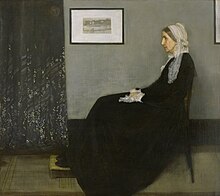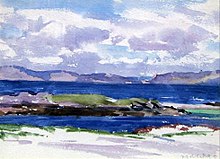Royal Glasgow Institute of the Fine Arts
The Royal Glasgow Institute of the Fine Arts is an independent organization founded in 1861 that promotes contemporary art and artists in Scotland . It is the third largest organization of its kind in the UK . The institute organizes the largest and most prestigious annual exhibition in Scotland, which is open to all artists and which is endowed with around 17 cash prizes. The exhibitions take place in the Kelly Gallery .

history









As a center of trade and industry , Glasgow was one of the most important cities of the British Empire until the mid-19th century . The city had numerous theaters , concert halls and libraries , but no exhibition space for works by contemporary painters and sculptors. From the 1780s onwards, various organizations had tried unsuccessfully to fill this void. A permanent solution was only achieved with the establishment of the Glasgow Institute of the Fine Arts . To this end, on May 29, 1861, a group of about ten prominent citizens of Glasgow met on Buchanan Street to discuss the organization of an annual exhibition of the works of living artists. About half of this group were artists. The cost of the first exhibition, which took place at the end of 1861, was estimated at £ 500. While 101 paintings were sold, the real cost was over £ 1,000 so the profit was only £ 55. The audience success was enormous with 39,099 visitors. Therefore, despite the disappointing financial result, plans were made for further exhibitions.
The shows that followed confirmed this decision. 45,327 people visited the second exhibition, 53,000 the third, and the numbers rose steadily over the next twenty years. However, this surprising success presented a number of problems. In the years that followed, a rapidly growing number of paintings had to be viewed. One of the reasons for the many submissions was that the Royal Scottish Academy regularly rejected a large number of the submitted works. Soon the rooms in the Corporation Galleries became too small for the size of the exhibition. In any case, the owners of the Corporation Galleries were not satisfied with the monthly rental in the long term. The company therefore acquired its own location on Sauchiehall Street and set up galleries there. The first exhibition in the new premises was held in 1879.
As the exhibition grew, so did its importance and quality. There was also a clear demarcation between the Glasgow Institute and the Scottish Academy. In addition, the institute decided to not only sponsor local artists but also host modern painting shows from across the UK. A start was made by borrowing paintings from collections of local art lovers. In this way, paintings by William Turner , John Constable and numerous French artists were made available to a large audience in the 1870s. Agents were finally hired to look for suitable pictures for the institute in London. Thus, in the 1880s, some of the most famous English artists became regular exhibitors at the Glasgow Institute, including John Everett Millais , William Holman Hunt , Edward Poynter , Frederic Leighton , George Frederic Watts , Edward Burne-Jones , John Singer Sargent , James McNeill Whistler, and Albert Joseph Moore . French and Dutch paintings were regularly exhibited by collectors or dealers.
The exhibition of French painters from the Barbizon School and younger artists such as Jules Bastien-Lepage had a profound effect on a group of young Scottish painters from the Glasgow School , including Frances MacDonald McNair , Margaret MacDonald Mackintosh , William York MacGregor , James Guthrie , Arthur Melville , Joseph Crawhall , Edward Arthur Walton , James Paterson , Edward Atkinson Hornel and Thomas Millie Dow . Their success at home and abroad, coupled with the great international exhibition of 1888, drew the attention of the entire art world to Glasgow and the Institute of the Fine Arts. Little by little the young artists took their place in the Hanging Committee , which decided on the selection of the pictures to be hung. This made the orientation of society much more modern. During this period until at least 1914, the Institute annually presented the most interesting and daring exhibitions of modern art in Scotland. Only the Royal Academy of Arts in London had a comparable variety of works of art. In recognition of its considerable success, Queen Victoria granted the institute a royal statute in 1896. Because of this Royal Charter , the company could now call itself the Royal Glasgow Institute of the Fine Arts .
However, the advantages that the institute gained from its own galleries were soon offset by increased operating costs. Now the society was no longer the organizer of a single annual event, but in its own interest had to keep the galleries busy throughout the year. This is why the institute also used the rooms for smaller exhibitions of pastel and watercolor paintings by members. In addition, the galleries were also made available to other societies such as the Royal Scottish Society of Painters in Watercolor . Nevertheless, the income was insufficient to cover the running fixed costs of the administration. Much of the capital had been invested in the new building. Active assets had also dwindled as part of the painting collection had been sold to fund the galleries. Therefore, in 1902, after the new Corporation Art Gallery opened in Kelvingrove, the decision was made to sell their own building on Sauchiehall Street and rent the McLellan Galleries again, which were now easier to reach. The sale cleared the debts, but Glasgow lost one of its most beautiful galleries. Badly damaged by a major fire, the building on Sauchiehall Street was finally demolished in the early 1970s.
Despite the outbreak of World War I in 1914, the Royal Glasgow Institute did not interrupt the exhibition program, but continued to support many artists from the Dumfries and Galloway area in southern Scotland, especially as they have become society's most important capital over the past decade were. Outstanding among these were John Lavery and George Henry , two of the Glasgow Boys who had settled in London before the war and were now part of the English art establishment. At this point they were already part of the old guard, along with other representatives of the Glasgow Boys such as Guthrie, Walton and Hornel. But also numerous younger painters, more in contact with the latest developments at home and abroad, appeared regularly. The most famous of these were Samuel Peploe , George Hunter and Francis Cadell , who had a direct connection to pre-war Paris and the paintings of Henri Matisse and Pablo Picasso . After the end of the war in 1918, French paintings were rarely seen in exhibitions. Avant-garde works from southern Scotland were also no longer represented as often.
The Royal Glasgow Institute has also struggled with changing artistic trends and, like many galleries of its size, struggled to attract the younger generation of experimental painters and sculptors. The younger artists saw the academies and institutes as outdated and old-fashioned and therefore often arranged their own events and exhibitions in other places. There had been a similar reaction to the Royal Academy of Arts in London earlier in the 1880s , when the Glasgow Boys, Newlyn School, and the London Impressionists founded the New English Art Club as an alternative to the Royal Academy. Similar clubs now sprung up in Scotland, including the Society of Eight in Edinburgh , whose members included Archibald McGlashan , Samuel Peploe and Francis Cadell. In 1939 John Duncan Fergusson settled in Glasgow and helped found the New Art Club . Other small groups soon formed that wanted to represent a modern alternative to the institute. By refusing to send their works to the institute or academy, the young painters exacerbated this situation and left it to the more traditional painters to submit their works. In addition, older and conservative forces moved up into the decisive bodies of the Royal Institute, so that the society no longer appeared to be out of date.
Like many other established institutions, the Institute had to accept in the years that followed that the best contemporary and modern painting was no longer on view in Glasgow. This development came in handy for the traditionalists, especially since financial independence was secured thanks to the presence of entrepreneurs in the company's bodies. The influence in society shifted more and more in favor of the older generation of painters and laypeople, who continued the conservative course.
In the 1950s and in the decades that followed, there were repeated efforts to rekindle the enthusiasm that the institute had generated in the first fifty years of its existence. The generous donation from the John D. Kelly Gallery gave the institute the opportunity to support individual painters through small exhibitions at a time when rooms were rare and expensive. The return to the practice of inviting out-of-town artists greatly expanded the Institute's options as many people took the opportunity to see works of art that were not normally found in Glasgow. The academic painters, whose taste dictates had dominated the annual exhibitions for a long time, could be pushed back, so that a return to the original objectives took place. Today the Royal Glasgow Institute has by far the largest and most visited exhibition of contemporary art. It shows again a wide variety of artistic works in very different styles and is not subject to any aesthetic censorship, as was widespread in the 1920s and 1930s.
Well-known exhibitors
- Jules Bastien-Lepage
- Dorothy Brett
- Edward Burne-Jones
- Francis Cadell
- Léon-François Comerre
- John Constable
- Thomas Millie Dow
- George Henry
- William Holman Hunt
- George Hunter
- John Lavery
- Frederic Leighton
- Frances MacDonald McNair
- Elizabeth MacNicol
- Alexander Mann
- John Everett Millais
- Albert Joseph Moore
- Norah Neilson Gray
- Samuel Peploe
- Edward Poynter
- Alexander Roche
- John Singer Sargent
- William Turner
- George Frederic Watts
- James McNeill Whistler
literature
- Roger Billcliffe: The Royal Glasgow Institute of the Fine Arts, 1861-1989: A Dictionary of Exhibitors at the Annual Exhibitions , Woodend Press 1990, ISBN 978-0951594506 .